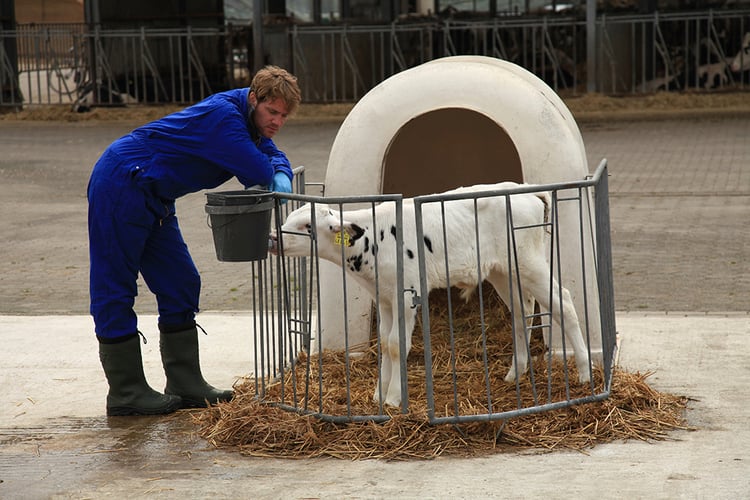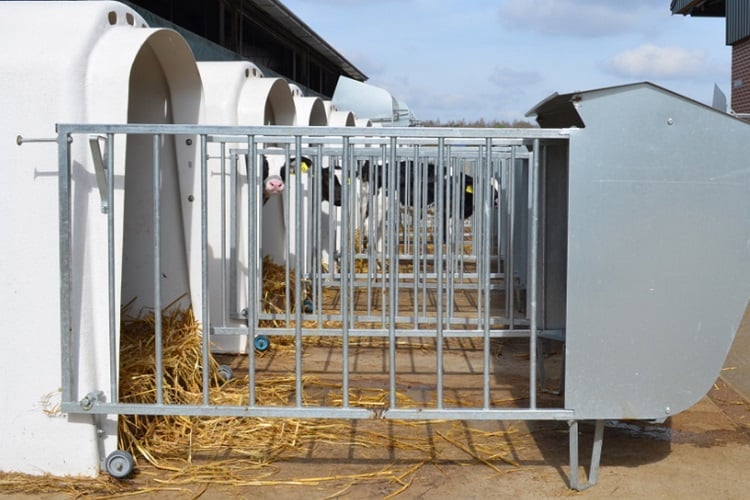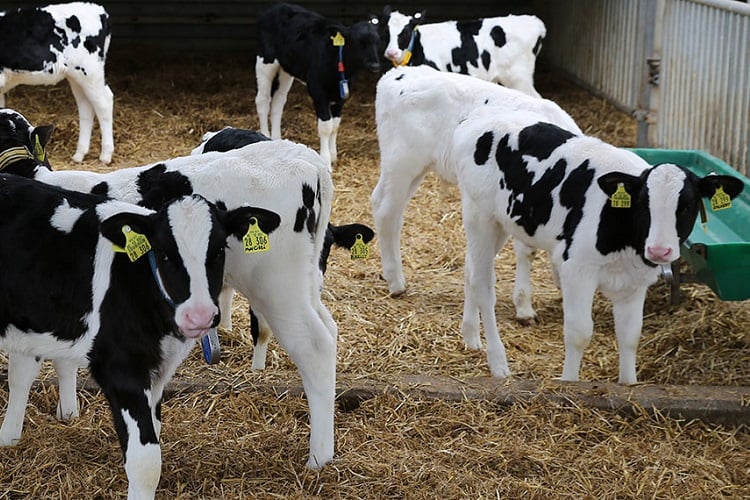- LifeStart
- Preweaning
Key takeaways from the research
-
When socially isolated, calves suffer from behavioural and developmental problems.
-
Group housed dairy calves are less fearful than those raised in isolation.
-
Group housed calves are more open to new situations and new food items than those reared in isolation.
-
Socially housed calves have a higher feed intake and grow better compared to individually housed calves.
-
Potential issues of socially housed calves with cross-sucking, competition, aggression and health require proper management.

Social housing of young dairy calves has long-term positive benefits
The housing of neonatal dairy calves has become the subject of much debate. A significant majority of dairy farms currently house newborn calves individually until they are weaned. The rationale behind this is biosecurity and reduction of disease risk. There are however concerns about the potential negative effects that social isolation can have on calves' behaviour, performance and health.
In nature, calves stay very close to their dams during the first week of life, but by the second week, they begin interacting with peers as well as forming small groups. They start grazing and ruminating by about the third week and graze regularly with the herd from about three months to six months of age. This social learning influences behavioural development, including knowledge of suitable food items[1] and lack of fear of new or unfamiliar foods.[2] Do neonatal calves, therefore, need to be housed socially and if so, is this possible without potential health and behavioural problems? In "Effects of group housing of dairy calves on behavior, cognition, performance, and health," J.H.C. Costa et al.[3] review the available scientific research on the effects of social isolation on calves' development and compare it to the effects of various types of group housing.
Effects of social isolation
Research has shown that many species develop abnormal behaviour when socially isolated. In nature, dairy calves tend to form strong social connections at a very young age.[4] Understanding the effects of social isolation on a variety of behavioural criteria, therefore, required choosing the correct housing for calves. It turns out that socially reared calves are less fearful than calves reared in social isolation.[5] Social buffering, or the ability of social partners to decrease the effect of stressors during a challenge, has strong effects on calves. Calves vocalize less when in a new area when they are accompanied by calves they are familiar with, as compared to when they are with unfamiliar calves.[6] Individually housed calves have a stronger vocal response to weaning than paired calves.[7]
As farm animals often experience novel events such as changes in pen location, regrouping, and changes in diet, the ability to cope with novelty is quite important. However, it has been shown that individually housed calves are far more reactive to social and environmental novelty.[8] On the contrary, socially housed calves have a reduced behavioural and physiological reactivity to a variety of stimuli, including being less fearful of new food items. Additionally, early-life social isolation leads to lower performance on key measures of cognition and learning.[9]
Thus, calves raised in isolation seem to exhibit deficient social skills, difficulty coping with new situations and poor learning abilities, all of which could hinder their performance on dairy farms which always have changing environments. These negative effects of social isolation might persist. While the evidence does seem to suggest that group housing of young calves is beneficial, it's important to fully understand both the potential positive outcomes and the constraints associated with it.
The benefits of group housing for dairy calves
There is a large and growing body of evidence that shows that social housing positively influences dairy calf performance. Socially housed neonatal dairy calves have higher intakes of solid feed and increased body weight gains compared to individually housed calves. The exact mechanism of social influence on feeding behaviour needs further study. Many studies have demonstrated a positive influence of social housing on various calf performance indicators such as early onset of puberty and increased milk production in first and later lactations.[10]
The challenges associated with group housing
The challenges associated with the social housing of neonatal calves can, for the most part, be overcome with proper management. There have been reports of increased cross-sucking[13] when calves are housed socially, but other studies have reported little or no increase in this behaviour[12]. The use of teat feeders, enhanced milk feeding programs, and more gradual weaning procedures seem to mitigate the desire to cross-suck.
Increased competition and aggression have been reported in calves that are socially housed. This behaviour can be managed by providing enough milk and ample feeding stations, and by designing and placing these stations effectively.
Arguably, one of the main reasons dairy farmers isolate neonatal calves is to reduce the risk of disease, in particular respiratory disease. There is however little evidence of a consistent relationship between calf health and individual housing. Many empirical studies have found no health advantage of housing calves individually[13]. Factors such as the amount and quality of milk fed, hygiene, group size, ventilation, colostrum protocols and bedding management have much more influence on the risk of disease than group housing.
Conclusion
Ultimately, the positive aspects of housing young calves socially do seem to outweigh the negative outcomes derived from their social isolation. With proper management, the perception of risk that comes with group housing can be minimised and pre-weaned calves can be given a better chance at meeting higher performance goals.
References
[1] Boyd, R., Richerson, P.J. Why culture is common, but cultural evolution is rare. Proc. British Acad. Symp.Oxford Univ., Oxford, UK; 1996:77–94.
[2] Costa, J.H.C., Daros, R.R., von Keyserlingk, M.A.G., Weary, D.M. Complex social housing reduces food neophobia in dairy calves. J. Dairy Sci. 2014; 97:7804–7810.
[3] Costa, J.H.C., von Keyserlingk, M.A.G. and Weary, D.M. Effects of group housing of dairy calves on behavior, cognition, performance, and health. J Dairy Sci. 2016; 99:1-15.
[4] Færevik, G., Jensen, M.B., Bøe, K.E. Dairy calves social preferences and the significance of a companion animal during separation from the group. Appl. Anim. Behav. Sci. 2006; 99: 205–221. And Duve, L.R., Jensen, M.B. The level of social contact affects social behaviour in pre-weaned dairy calves. Appl. Anim. Behav. Sci. 2011; 135:34–43.
[5] Bøe, K.E., Færevik, G. Grouping and social preferences in calves, heifers and cows. Appl. Anim. Behav. Sci. 2003; 80:175–190.
[6] Færevik, G., Jensen, M.B., Bøe, K.E. 2006; Op cit.
[7] de Paula Vieira, A., von Keyserlingk, M.A.G., Weary, D.M. Effects of pair versus single housing on performance and behavior of dairy calves before and after weaning from milk. J. Dairy Sci.2010; 93:3079–3085.
[8] Jensen, M.B., Vestergaard, K.S., Krohn, C.C., Munksgaard, L. Effect of single versus group housing and space allowance on responses of calves during open-field tests. Appl. Anim. Behav. Sci.1997; 54:109–121.
[9] Meagher, R.K., Daros, R.R., Costa, J.H.C., von Keyserlingk, M.A.G., Hötzel, M., Weary, D.M. Individual housing impairs reversal learning and increases fear of novel objects in dairy calves. PLoS ONE.2015; 10: e0132828.
[10] Moallem, U., Werner, D., Lehrer, H., Zachut, M., Livshitz, L., Yakoby, S., Shamay, A. Long-term effects of ad libitum whole milk prior to weaning and prepubertal protein supplementation on skeletal growth rate and first-lactation milk production. J. Dairy Sci. 2010; 93:2639–2650. And Soberon, F., Raffrenato, E., Everett, R.W., Van Amburgh, M.E. Preweaning milk replacer intake and effects on long-term productivity of dairy calves. J. Dairy Sci. 2012; 95:783–793.
[11] Lidfors, L., Isberg, L. Intersucking in dairy cattle—Review and questionnaire. Appl. Anim. Behav. Sci. 2003; 80:207–231.
[12] Chua, B., Coenen, E., Van Delen, J., Weary, D.M. Effects of pair versus individual housing on the behavior and performance of dairy calves. J. Dairy Sci. 2002; 85:360–364. And Mattiello, S., Canali, E., Ferrante, V., Caniatti, M., Gottardo, F., Cozzi, G., Andrighetto, I., Verga, M. The provision of solid feeds to veal calves: II. Behavior, physiology, and abomasal damage. J. Anim. Sci.2002; 80:367–375.
[13] Waltner-Toews, D., Martin, S.W., Meek, A.H. Dairy calf management morbidity and mortality in Ontario Holstein herds. I: The data. Prev. Vet. Med. 1986; 4:103–124 (a). Waltner-Toews, D., Martin, S.W., Meek, A.H. Dairy calf management, morbidity and mortality in Ontario Holstein herds. III. Association of management with morbidity. Prev. Vet. Med. 1986; 4:137–158(b). Perez, E., Noordhuizen, J.P.T.M., Van Wuijkhuise, L.A., Stassen, E.N. Management factors related to calf morbidity and mortality rates. Livest. Prod. Sci. 1990; 25:79–93. And Johnson, K., Burn, C.C., Wathes, D.C. Rates and risk factors for contagious disease and mortality in young dairy heifers. Anim. Sci. Rev. 2011; 205:101–113.



